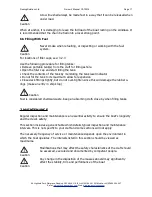
Danger
If a fuel leak or fumes are detected, do not start the engine.Ensure all crew leave the
boat and have a qualified person repair the fault as soon as possible.
Warning
Controls installed with the motor must have a start-in-gear v device. It is the owner's
responsibility to ensure this is so, should the engine or its controls be repaired/replaced.
6.2 Handling Characteristics
This craft is primarily intended to be supported by a combination of buoyancy and planing
forces
Maximum engine power: 7.2 kW 9.9 hp Maximum speed: 16 knots 18 mph
Periodic inspection of the propeller for excessive wear or damage is recommended in order
to maintain peak performance and to maximise the longevity of the engine.
Ensure all crew are informed about the craft's behaviour.
Before conducting any rapid acceleration or high-speed manoeuvres, passengers must be
warned to sit and hold-on.
The helmsman may have to take sharp avoiding action at any time. Passengers should,
therefore, be seated and holding-on when underway.
Caution
Seaways are infinitely variable and all craft can meet conditions that will
challenge the boats handling characteristics and/or the helmsman's ability.
Proceed with a margin for error at all times. Avoid making sharp turns at
speed, particularly in a short seaway.
It is strongly recommended that helmsmen receive adequate training in
boat handling before setting to sea for the first time.
Be aware that factors such as altitude, temperature, load, and bottom
growth may affect performance.
Seaways are infinitely variable and all craft can meet conditions that will
challenge the boats handling characteristics and/or the helmsman's ability.
Proceed with a margin for error at all times. Avoid making sharp turns at
speed, particularly in a short seaway.
It is strongly recommended that helmsmen receive adequate training in
boat handling before setting to sea for the first time.
Be aware that factors such as altitude, temperature, load, and bottom
growth may affect performance.
Caution
Seaways are infinitely variable and all craft can meet conditions that will
challenge the boats handling characteristics and/or the helmsman's ability.
Proceed with a margin for error at all times. Avoid making sharp turns at
speed, particularly in a short seaway.
It is strongly recommended that helmsmen receive adequate training in
boat handling before setting to sea for the first time.
Be aware that factors such as altitude, temperature, load, and bottom
growth may affect performance.
6.3 Visibility from the Main Steering Position
Information
Operator vision from the helm can be obstructed by high trim angles of the craft and other
factors caused by one or more of the following conditions:
RowingSolutions Ltd Owner’s Manual CAT2014 Page 15
66 Highfield Park, Wargrave, Reading. RG10 8LE. UK Tel: +44(0)1189 401 041 Mobile: +44(0)7860 224 007
E-mail:
Web:
www.rowingsolutions.com






































